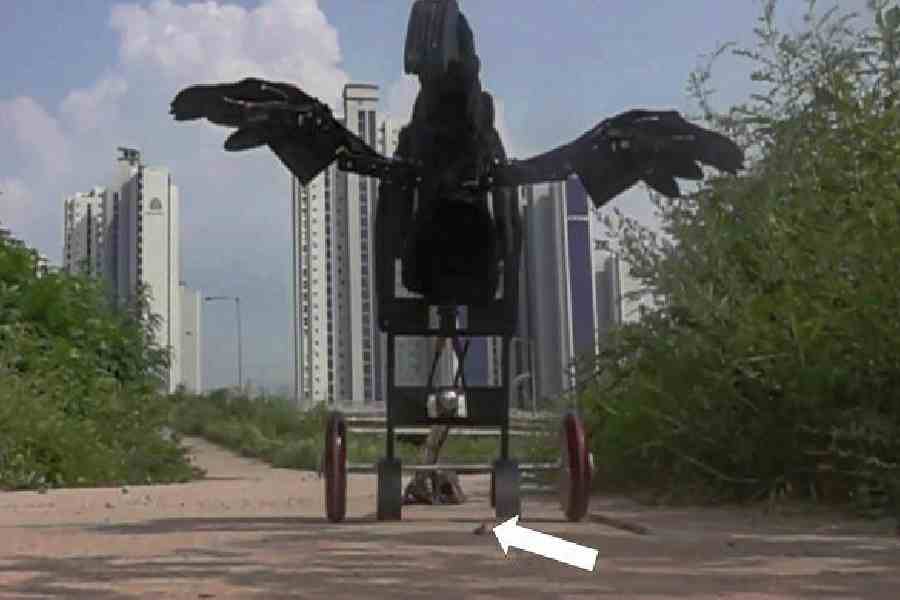The origin of bird wings has long presented a puzzle to palaeontologists: why did these structures develop in the age of the dinosaurs? And what were some of the earliest wings used for, if not for flight?
In research published in Scientific Reports, scientists used a robotic dinosaur and terrified grasshoppers to argue that small feathered dinosaurs might have flapped early wings to flush out insect prey. Their proposal adds an explanation for why wings evolved before flight.
“It’s been shown that the larger the wing display, the more insects the birds are catching and bringing to the nest,” said Piotr Jablonski, an ornithologist at Seoul National University, South Korea, and an author of the paper. “And, of course, if you see it in birds, you think about dinosaurs.”
Feathers first evolved in dinosaurs as hairy bristles, most likely used for insulation and display, said Steve Brusatte, a palaeontologist at the University of Edinburgh, UK, who did not participate in the paper. Only one family of dinosaurs evolved quill-shafted, pennant-like feathers, which eventually gave rise to wings and flight in modern birds. But researchers remain unsure whether such wings evolved to enable flight in an early lineage of dinosaurs or served another purpose.
Adding to the puzzle is the presence of early proto-wings on flightless bird relatives such as velociraptor and oviraptor, said Minyoung Son, a palaeontologist at the University of Minnesota, US, and an author on the paper. Palaeontologists have suggested multiple explanations, noting that even proto-wings give animals added manoeuvrability and enough lift to perform higher jumps. Others suggested they helped predators immobilise larger prey, assisted the brooding of eggs, or were a display to mates and rivals.
But wing displays can also be aimed at other species, Jablonski said. Some modern birds flash their wings as they hunt, revealing patches of white or contrasting feathers that frighten hiding prey.
The strategy, known as flush-pursuit, exploits the tendency for many insects to react automatically to quickly approaching shapes. The automatic response keeps them a jump ahead of most predators. But wing displays by flush-pursuers hack this system, causing prey to run too early. They reveal themselves and get eaten.
Many early winged dinosaurs were carnivores and insectivores, so Jablonski and his colleagues wondered if proto-wings might have evolved for a similar purpose. The team built Roboteryx, a turkey-size black robot with the basic size and shape of caudipteryx, a small omnivorous dinosaur from 124 million years ago.
Hyungpil Moon, an engineer at Sungkyunkwan University in South Korea and an author on the study, said the simple robot was able to mimic flush-pursuits.
The team unleashed Roboteryx on grasshoppers, an insect with roots in the Mesozoic Era and which is susceptible to this hunting strategy with modern birds. When Roboteryx went forth with naked arms, fewer than half of the tested grasshoppers fled. But when the researchers added structures resembling proto-wings to the arms, 93 per cent of the grasshoppers bolted. The jumping insects also scattered more often when striped tail feathers were added.
Proto-wings’ effectiveness at scaring prey might have helped early-winged dinosaurs reach greater heights. Successful flush-pursuers tend to have adaptations for fast running, manoeuvrability and balance, Jablonski said. The same wings that scared insects also allowed for rapid changes in pursuit speed and direction in small dinosaurs.
The new suggestion doesn’t contradict the previous hypotheses, those related to using wings for signalling, Son said. Instead, the team suggests the early development of a flush-pursuit strategy gave rise to mutually reinforcing adaptations that could help explain how flight began.
For Julia Clarke, University of Texas, US, the study is a reminder of how multifunctional bird wings are beyond their role in flight. “It captures the real complexity of form-function relationships in the natural world. There is no reason ‘half a wing’ would need to have only one function,” she said.
NYTNS










